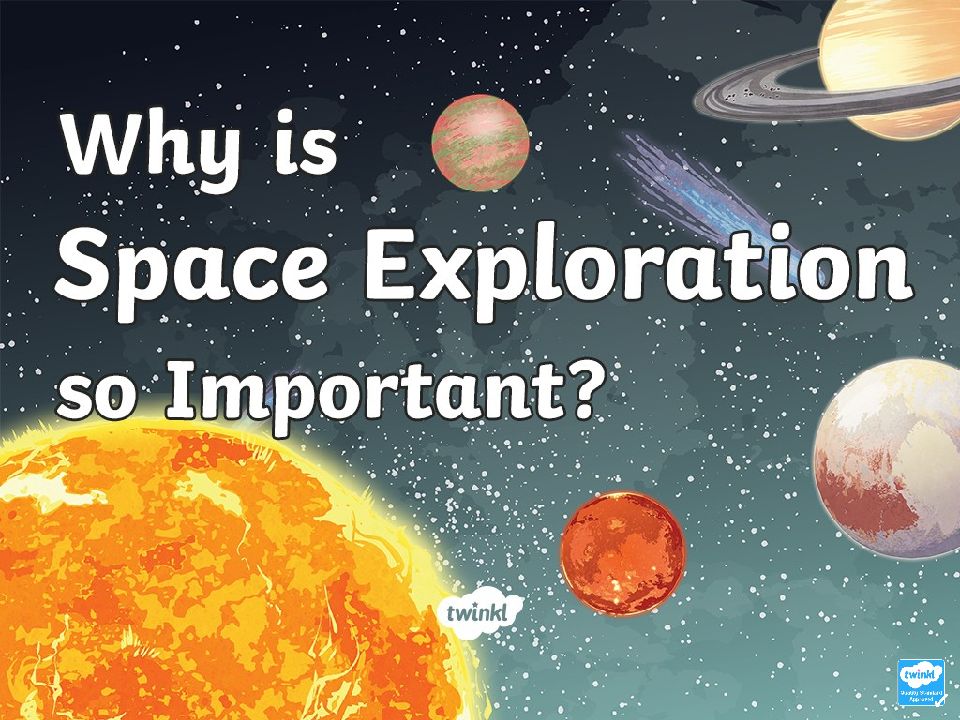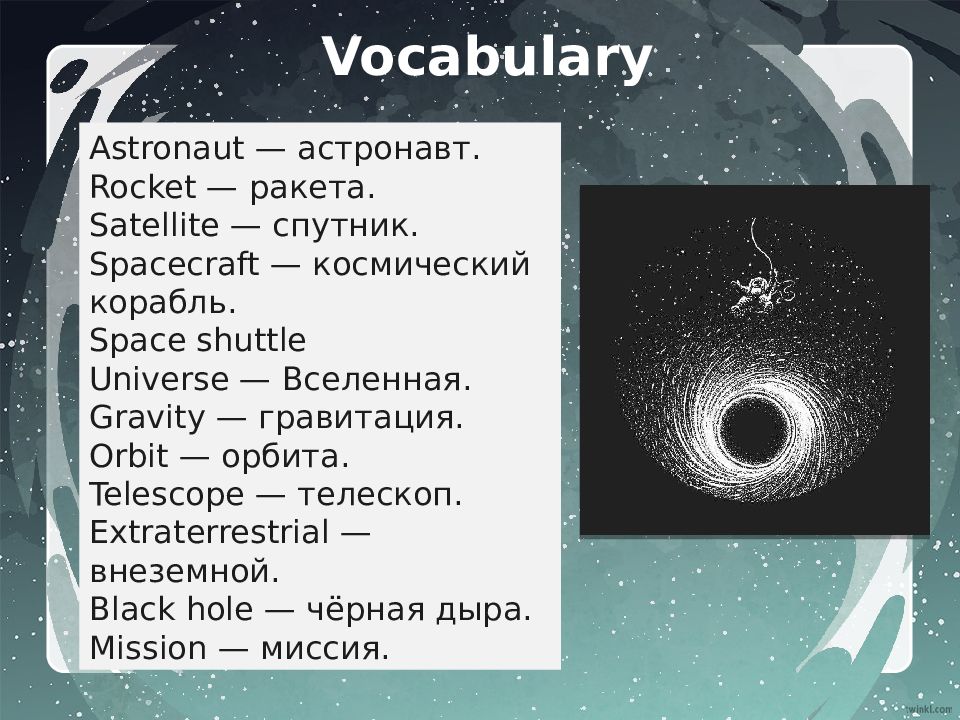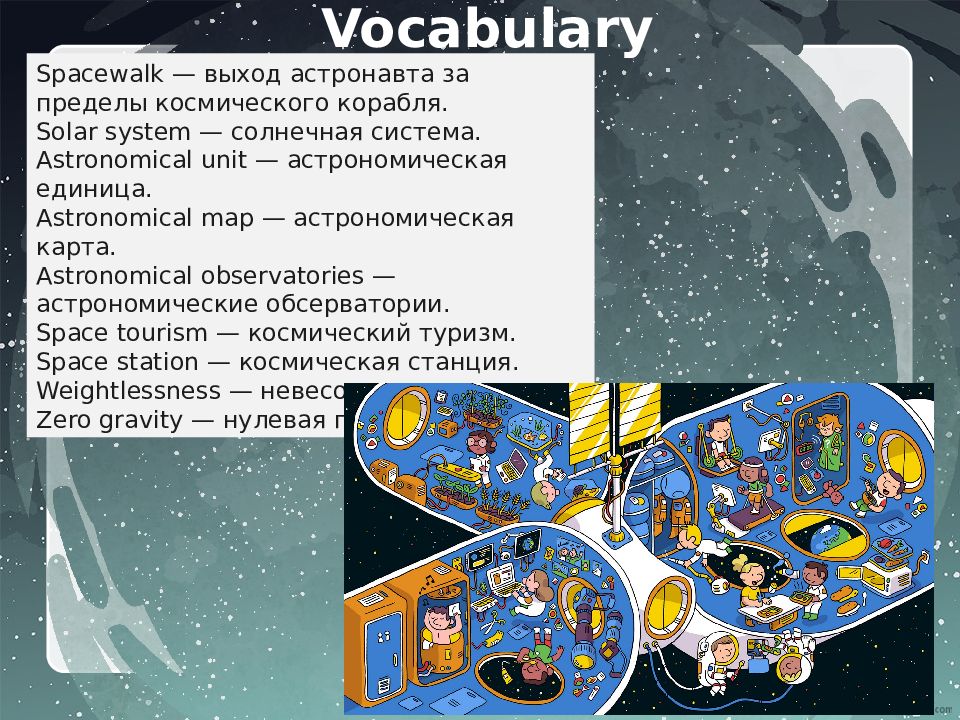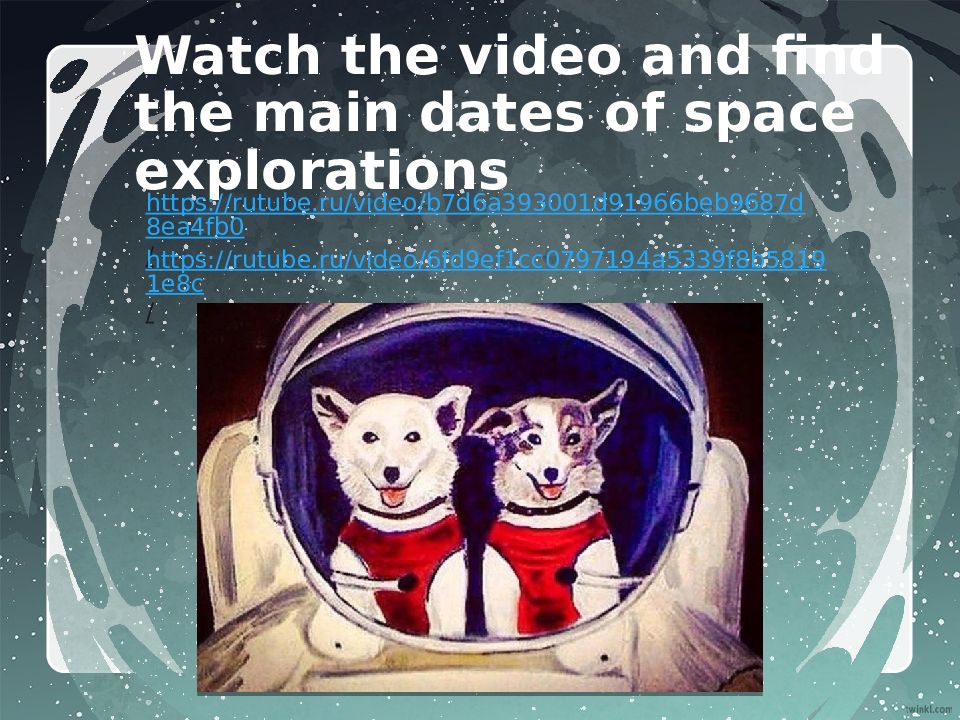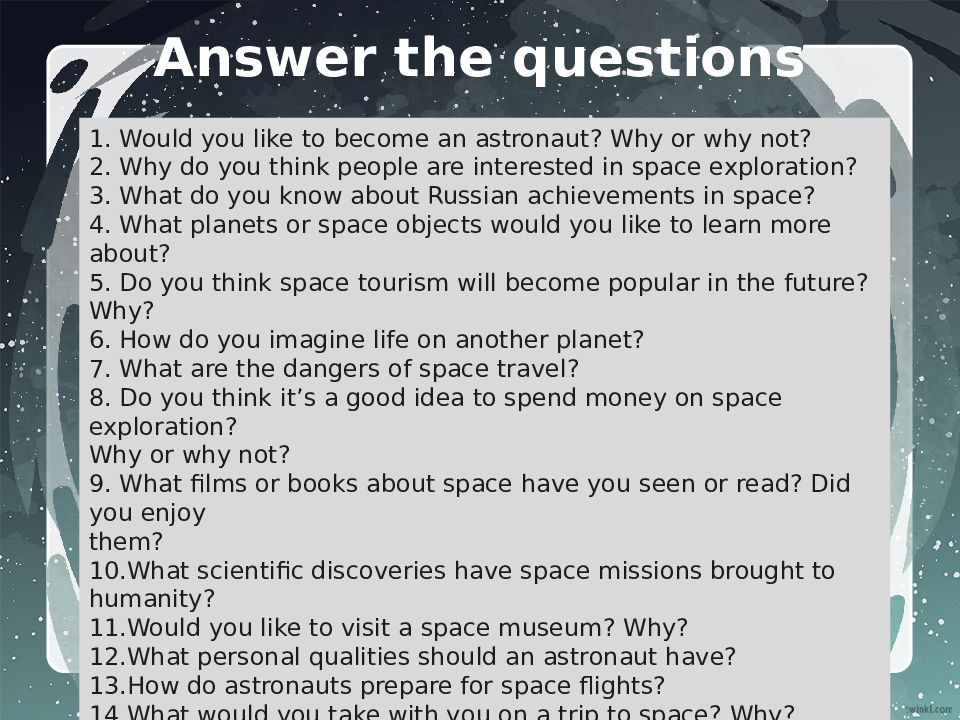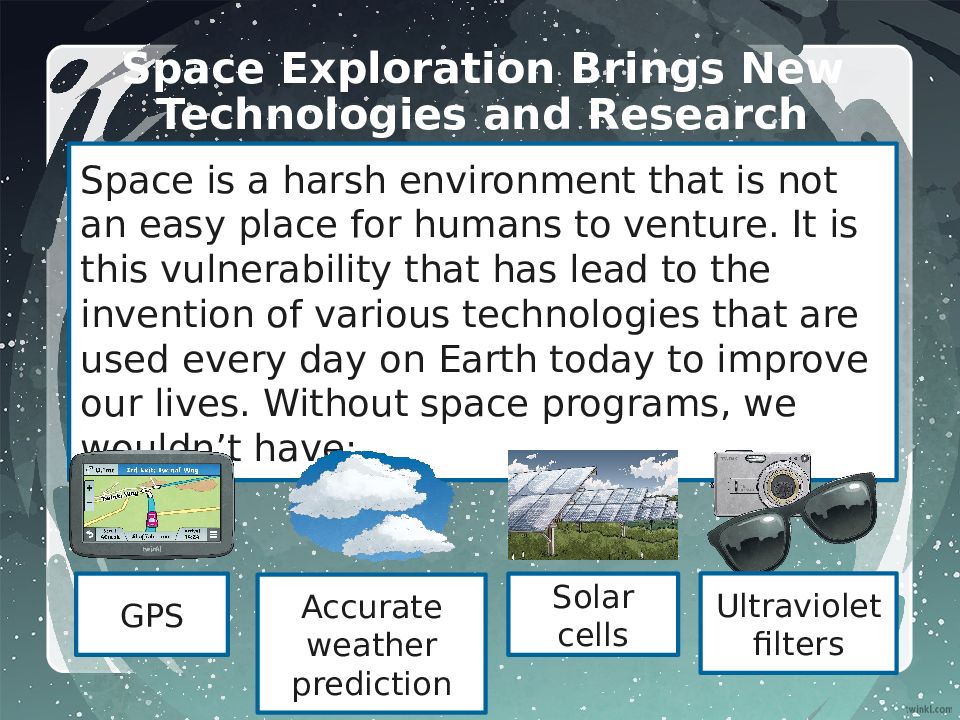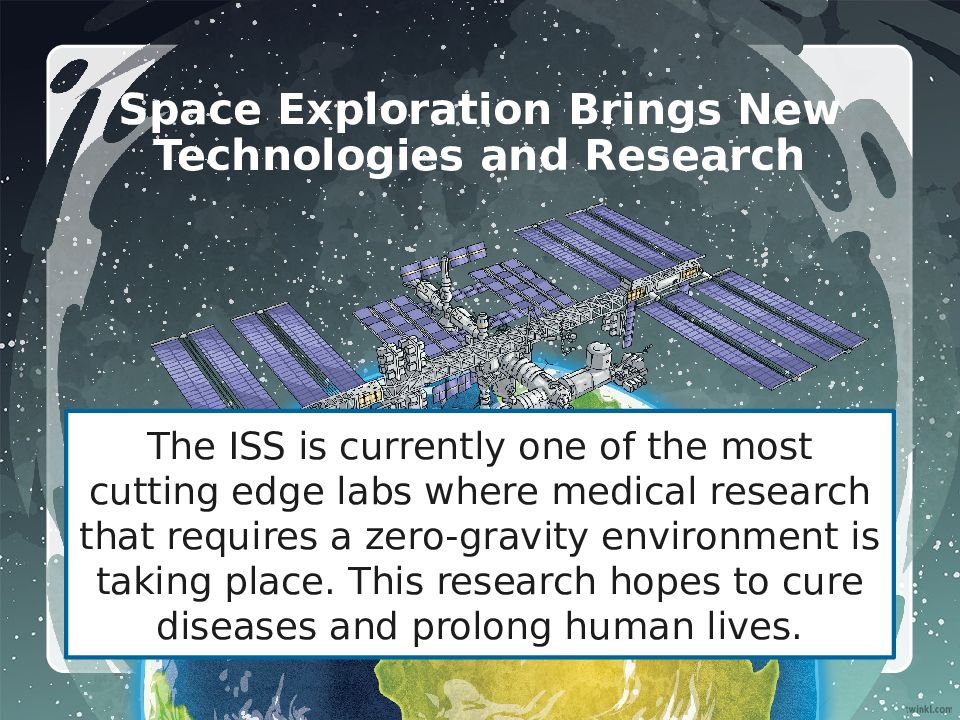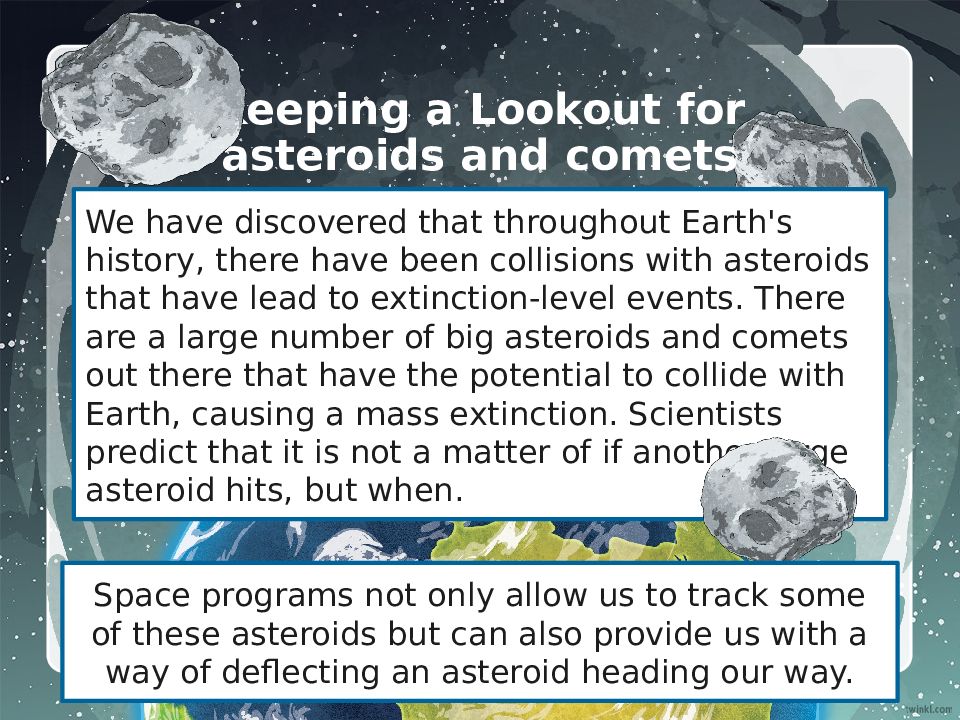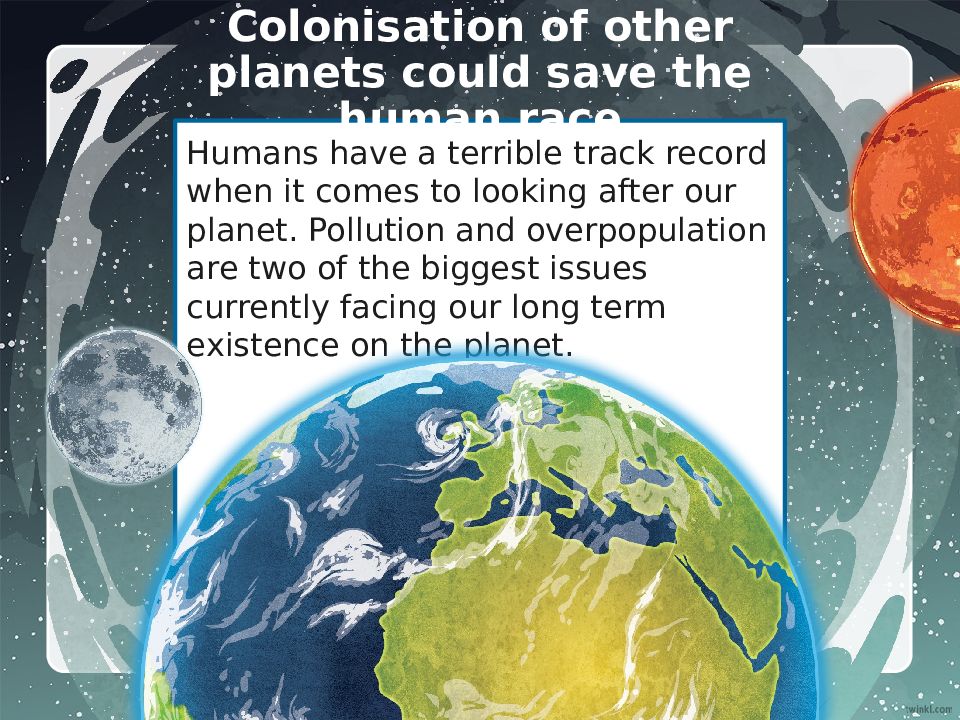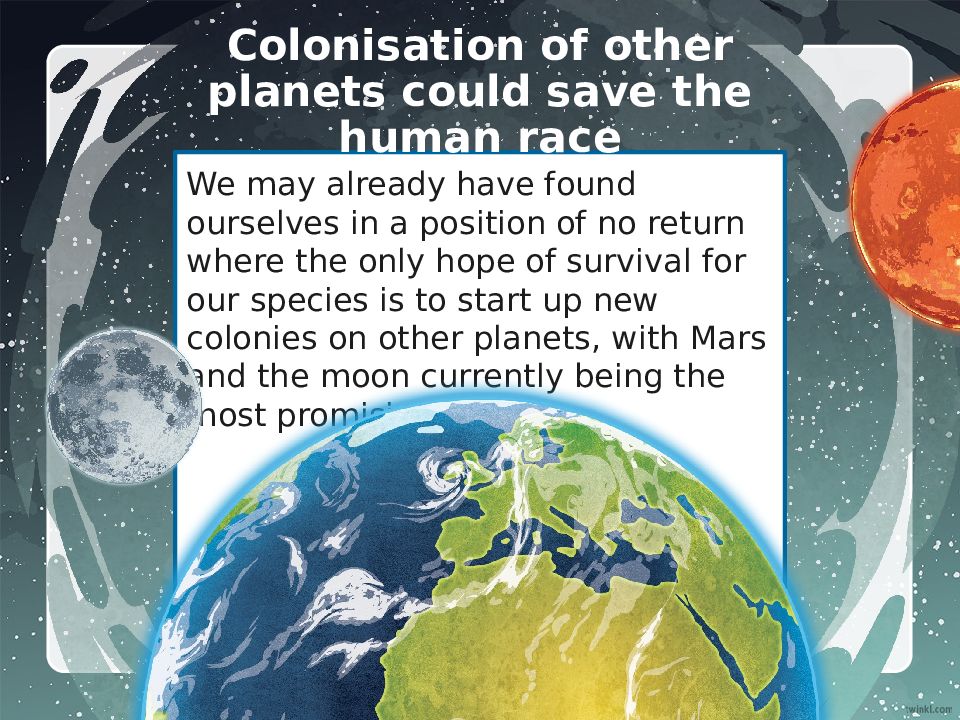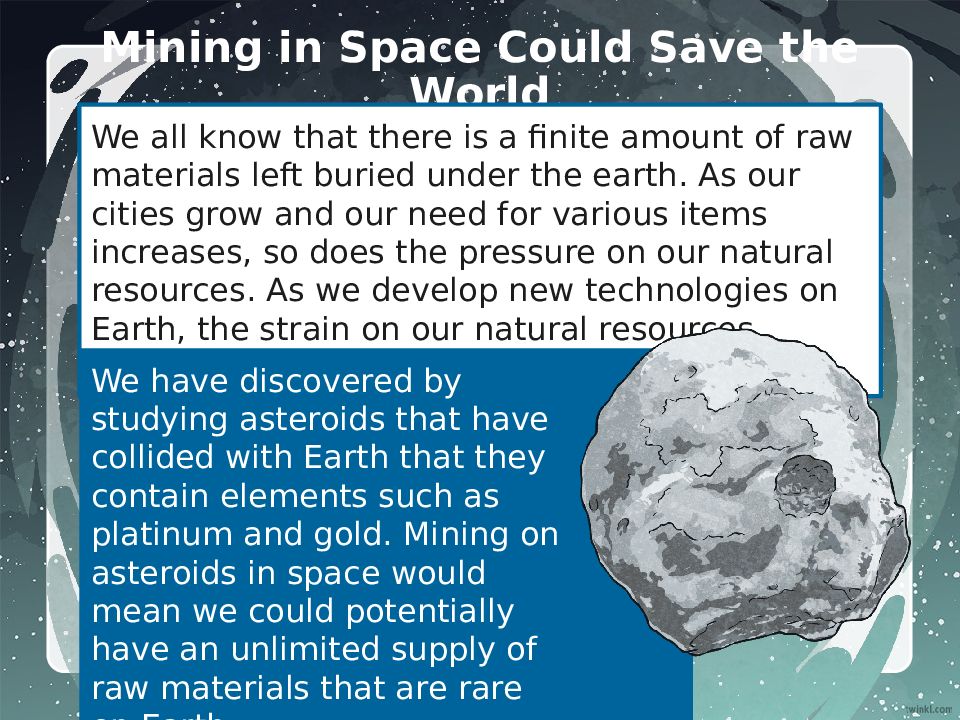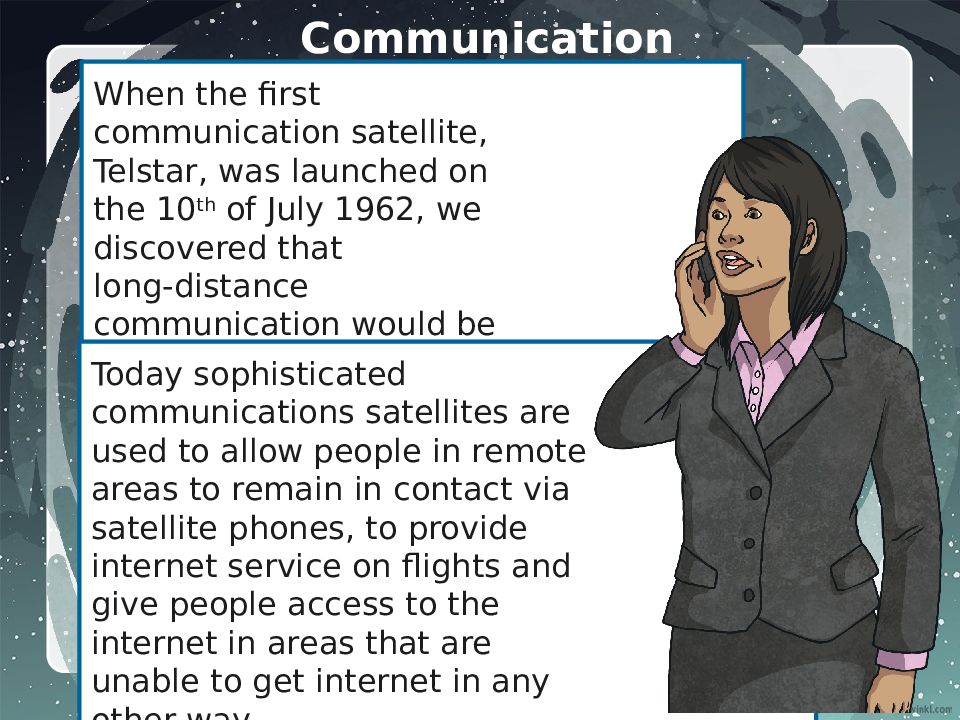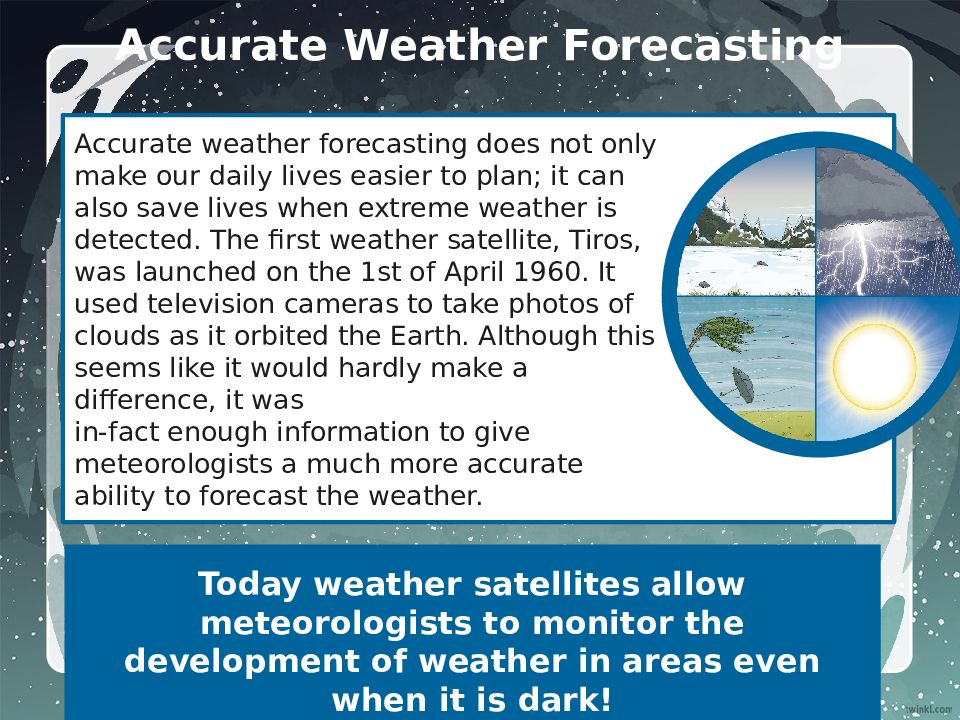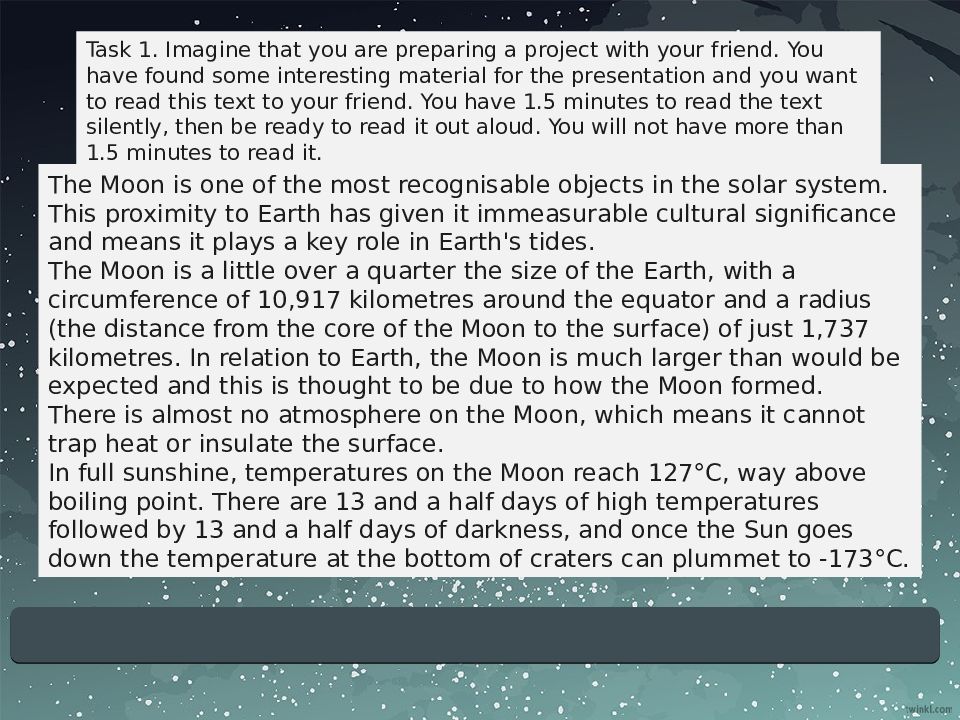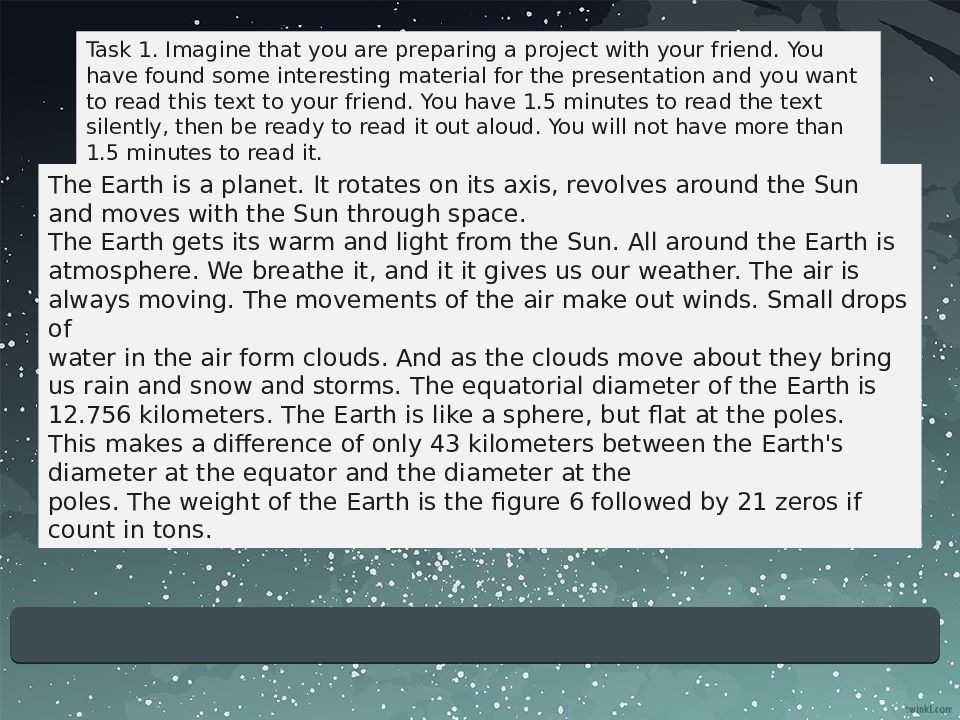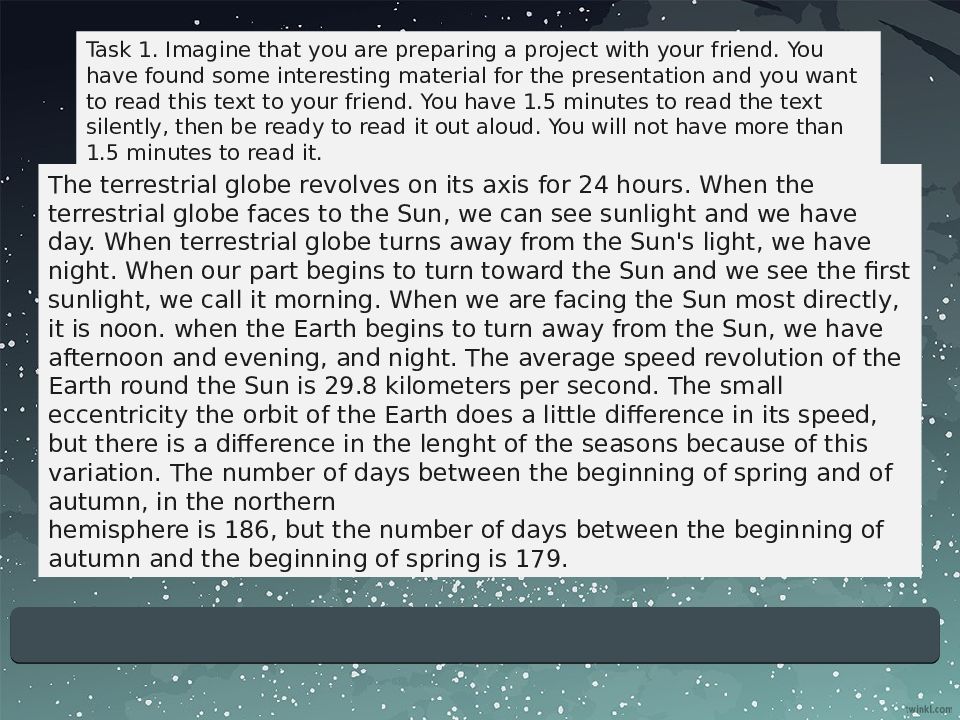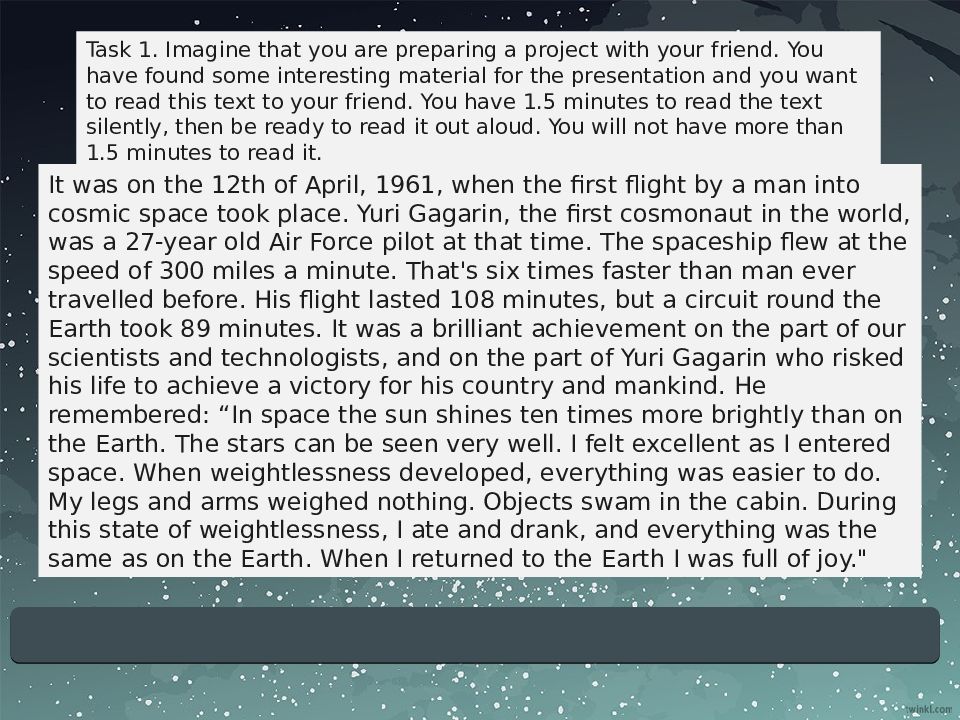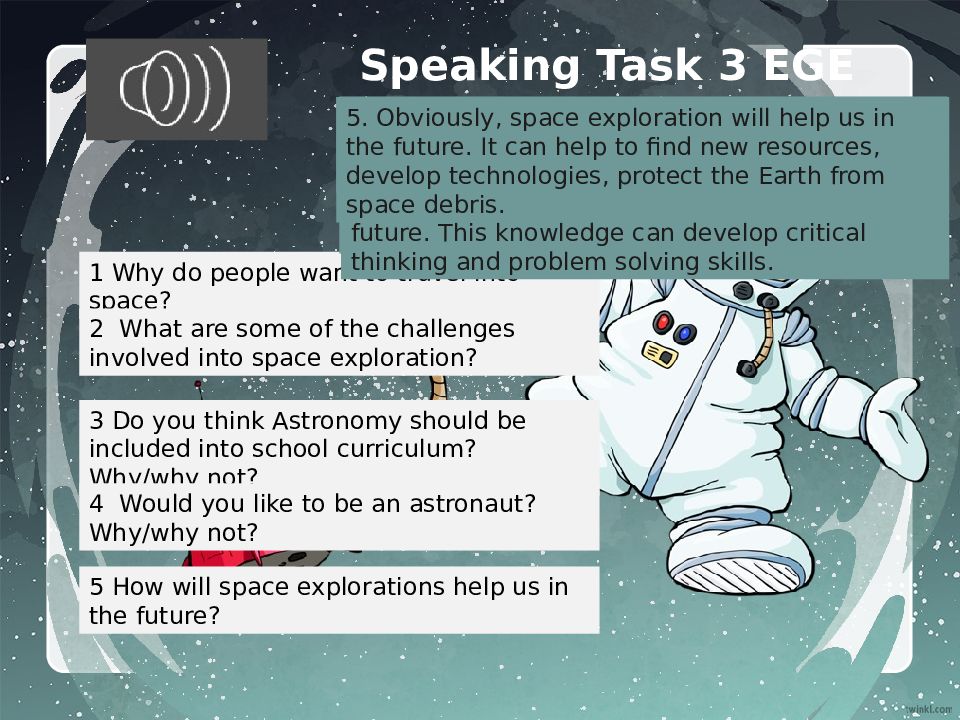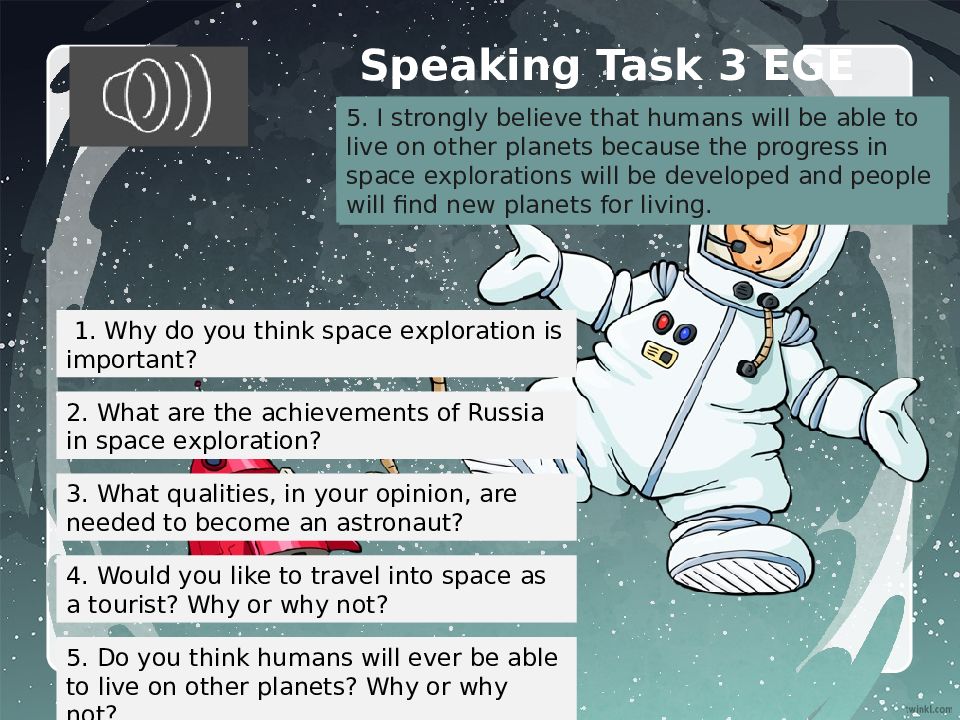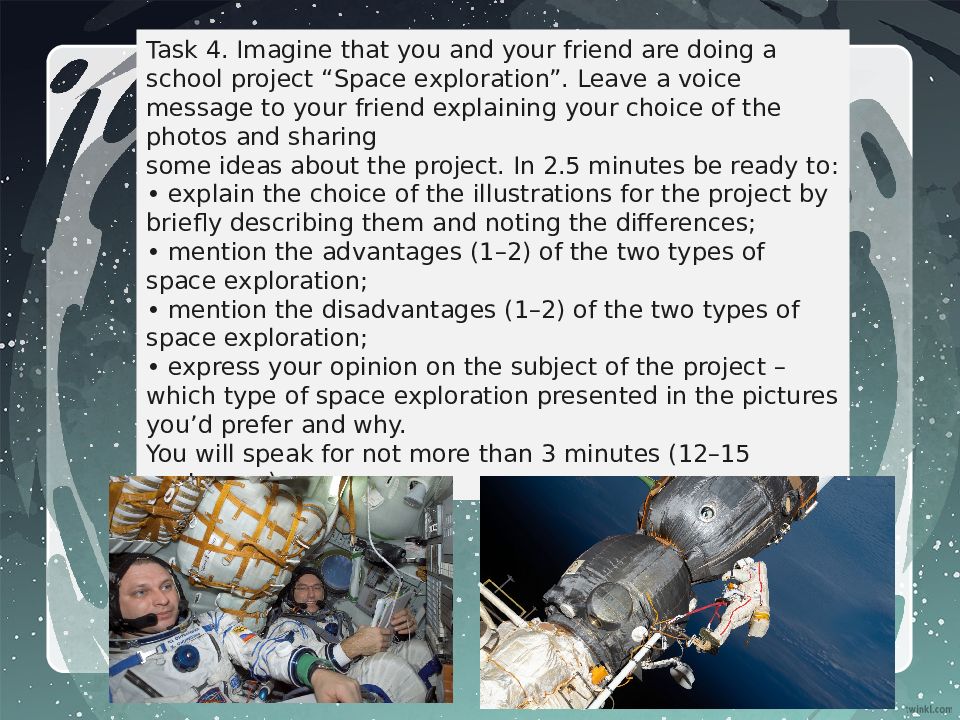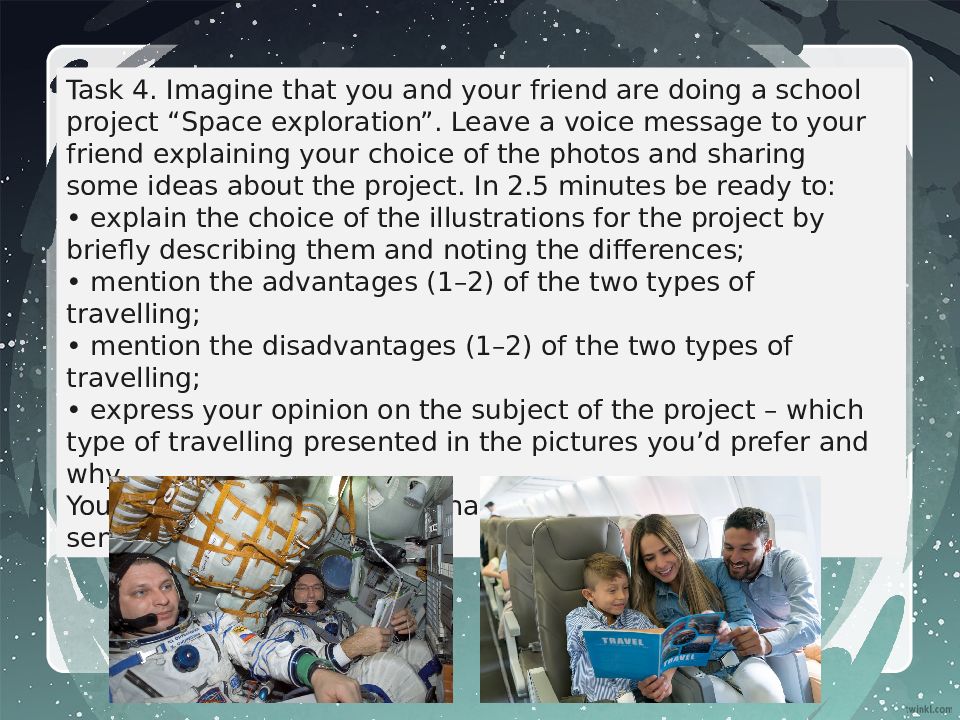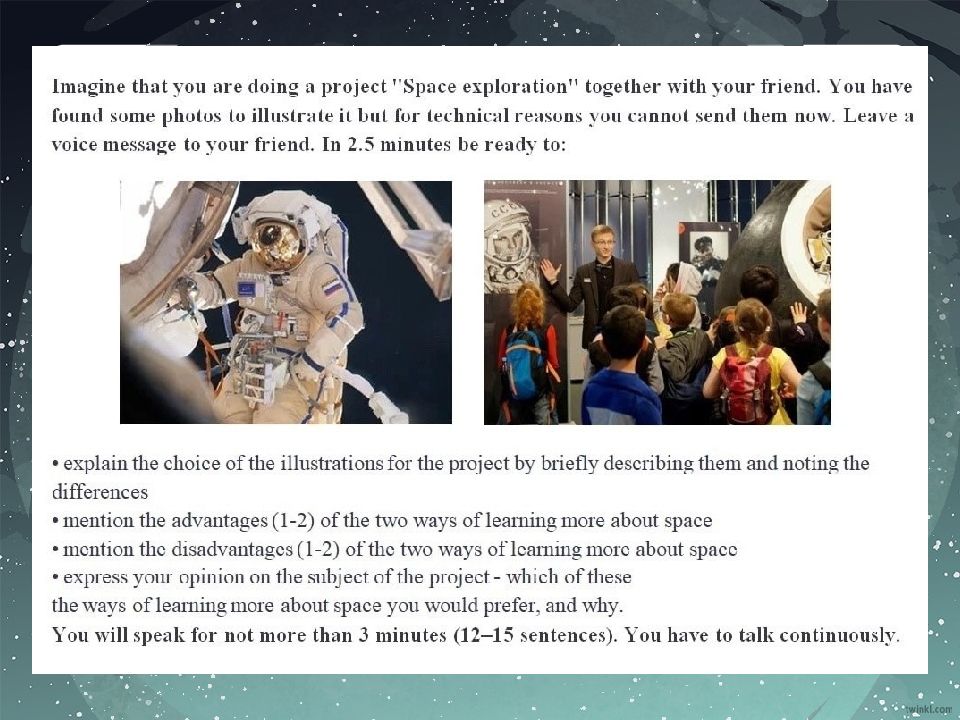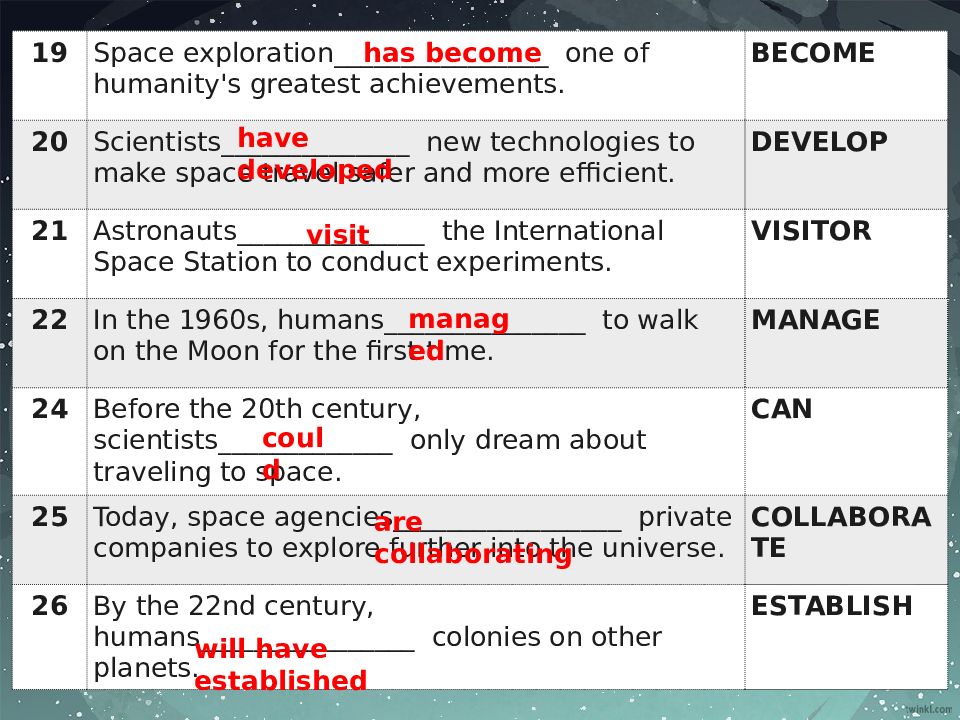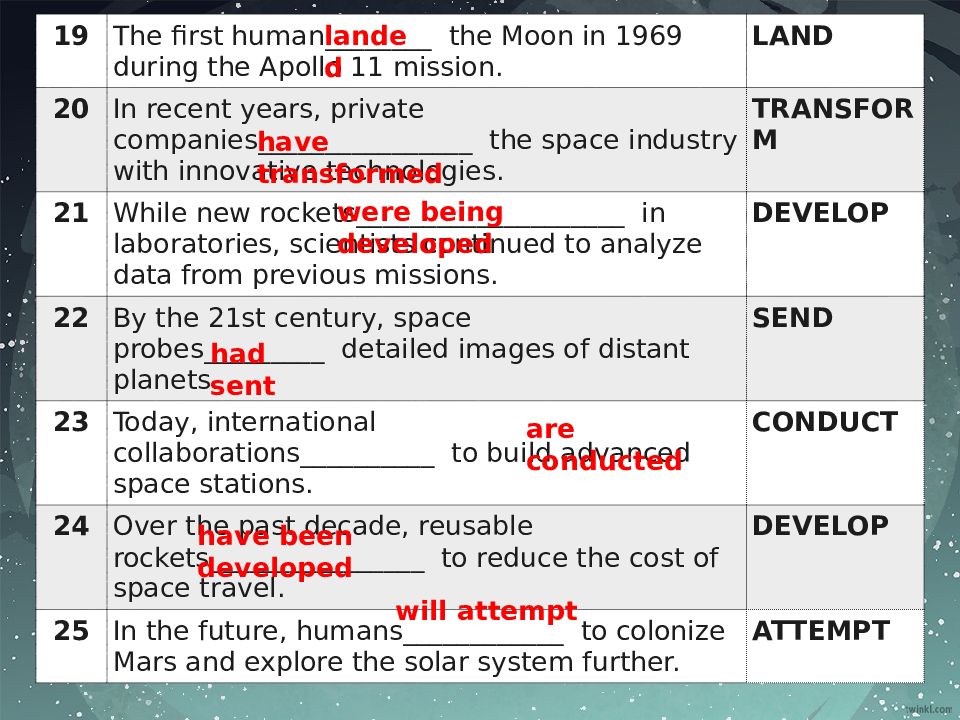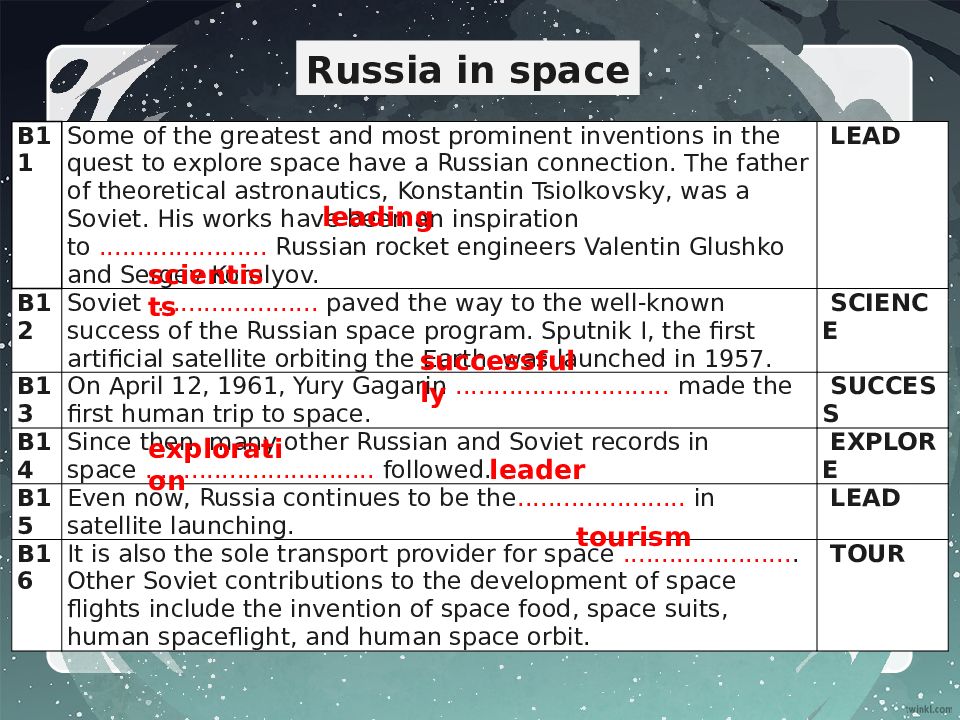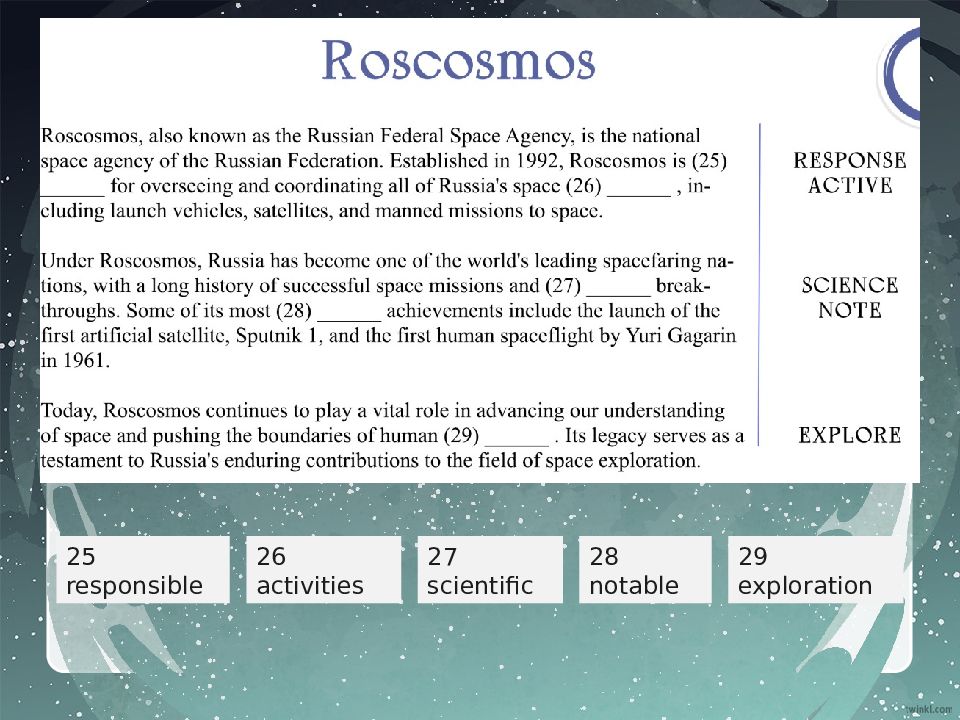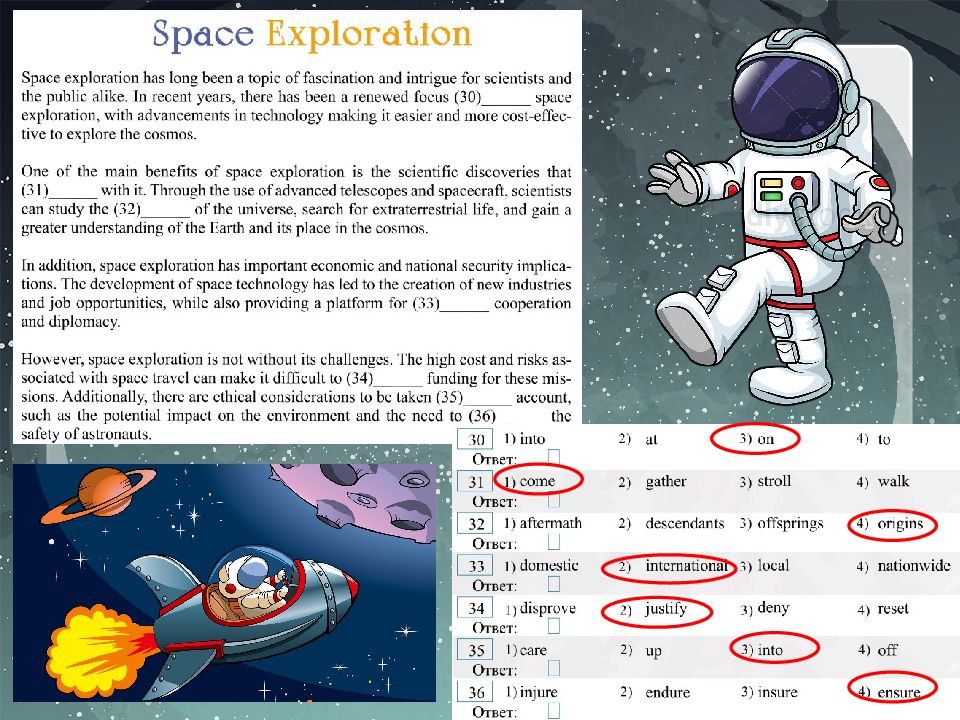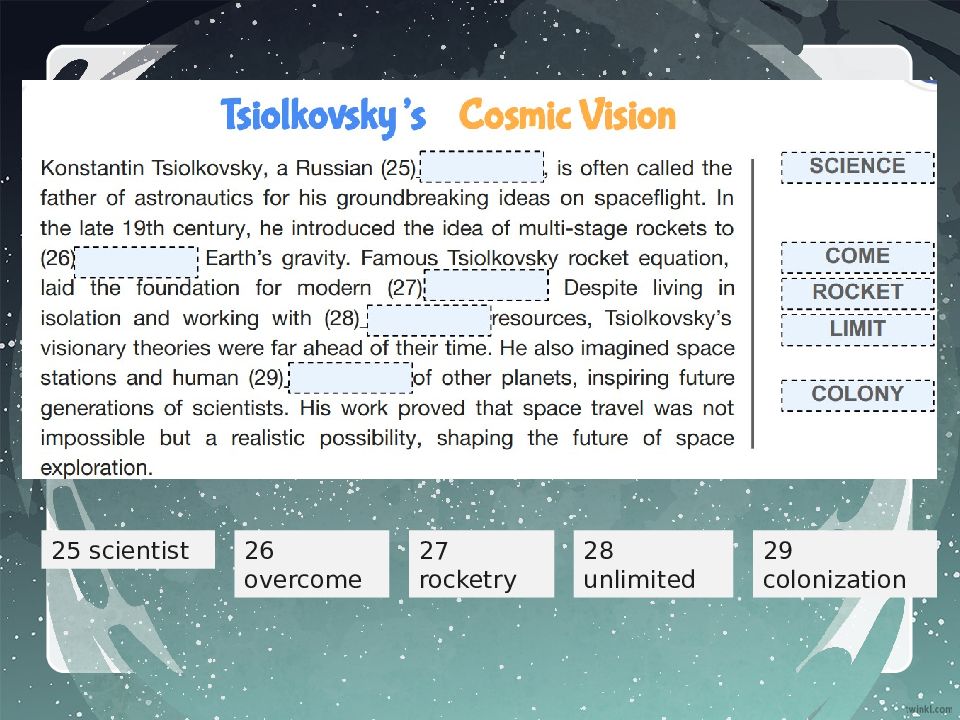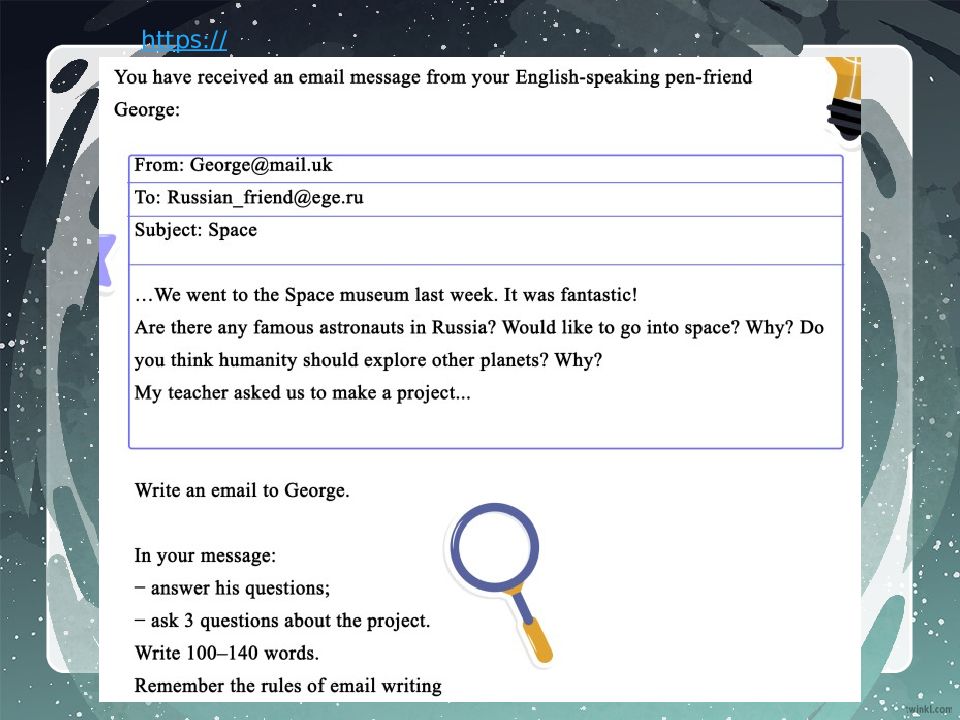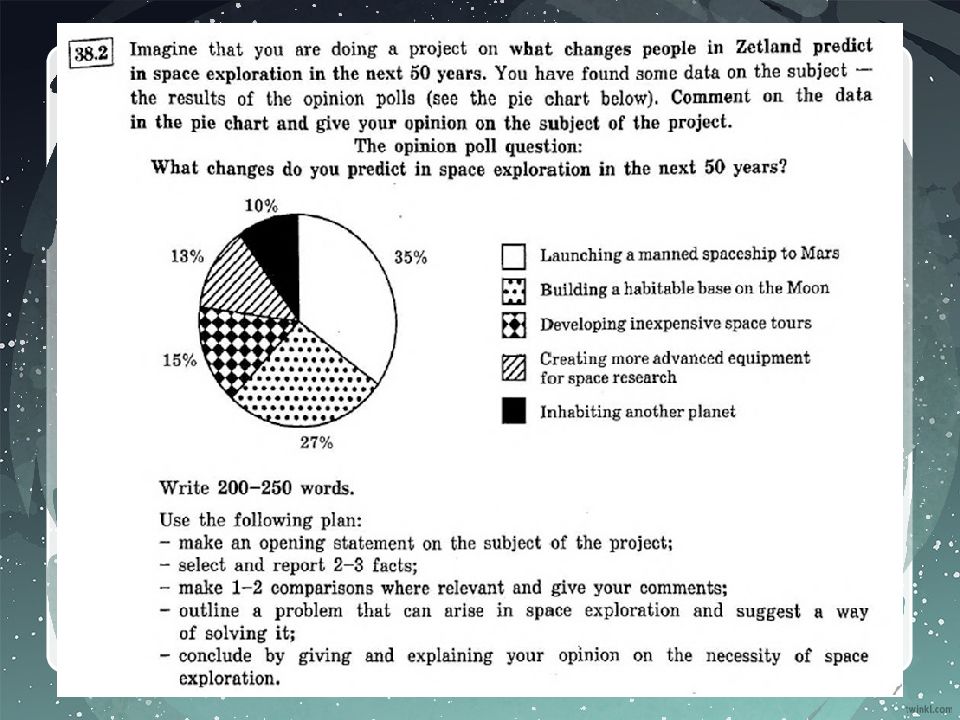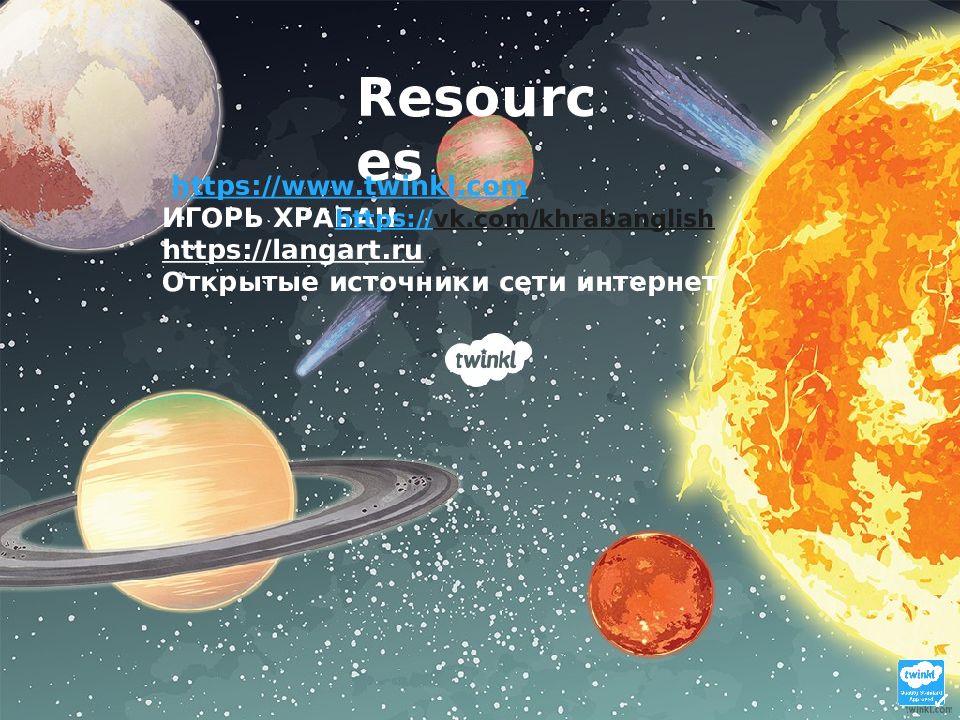Слайд 2: Vocabulary
Astronaut — астронавт. Rocket — ракета. Satellite — спутник. Spacecraft — космический корабль. Space shuttle Universe — Вселенная. Gravity — гравитация. Orbit — орбита. Telescope — телескоп. Extraterrestrial — внеземной. Black hole — чёрная дыра. Mission — миссия.
Слайд 3: Vocabulary
Spacewalk — выход астронавта за пределы космического корабля. Solar system — солнечная система. Astronomical unit — астрономическая единица. Astronomical map — астрономическая карта. Astronomical observatories — астрономические обсерватории. Space tourism — космический туризм. Space station — космическая станция. Weightlessness — невесомость. Zero gravity — нулевая гравитация.
Слайд 4: Watch the video and find the main dates of space explorations
https://rutube.ru/video/b7d6a393001d91966beb9687d8ea4fb0 / https://rutube.ru/video/6fd9ef1cc0797194a5339f8b58191e8c /
Слайд 5: Answer the questions
1. Would you like to become an astronaut? Why or why not? 2. Why do you think people are interested in space exploration? 3. What do you know about Russian achievements in space? 4. What planets or space objects would you like to learn more about? 5. Do you think space tourism will become popular in the future? Why? 6. How do you imagine life on another planet? 7. What are the dangers of space travel? 8. Do you think it’s a good idea to spend money on space exploration? Why or why not? 9. What films or books about space have you seen or read? Did you enjoy them? 10.What scientific discoveries have space missions brought to humanity? 11.Would you like to visit a space museum? Why? 12.What personal qualities should an astronaut have? 13.How do astronauts prepare for space flights? 14.What would you take with you on a trip to space? Why? 15.Do you think people will live on other planets one day? Why or why not?
Слайд 6
Name the people who played the significant role in the space exploration. What do you know about them? Konstantin Tsiolkovsky Sergei Korolyov Yuri Gagarin German Titov Alexei Leonov Valentina Tereshkova Svetlana Savitskaya Oleg Kononenko Russian and Soviet scientist and inventor in the field of aerodynamics, rocket dynamics, aircraft and airship theory, the founder of modern cosmonautics. Soviet scientist, designer of rocket and space systems. The first cosmonaut in the world The second Soviet cosmonaut and the second person to complete an orbital space flight. Carried out the first spacewalk in the history of cosmonautics. The first woman cosmonaut in the world. The second woman cosmonaut in the world. Setting a record for the total duration of human presence in space - 1110 days, 14 hours and 57 minutes.
Слайд 7: Why is Space Exploration Important?
Through space exploration, we have discovered information about our planet and the solar system in which we live. The quest for these answers has driven new technological inventions, new industries, and opportunities to work peacefully with other nations towards a common human goal. Why is Space Exploration Important? Humans have always had a desire to explore the unknown, learn more about our environment and discover new worlds. It is this desire and the interest in the heavens that continues to drive us to explore space. Many argue that space exploration is expensive and the money spent on these programs would be better spent here on Earth addressing issues such as poverty and hunger. However, there are many reasons why space exploration is important and should continue. Here are a few reasons why space exploration is vitally important to the human race.
Слайд 8: Space Exploration Brings New Technologies and Research
Space is a harsh environment that is not an easy place for humans to venture. It is this vulnerability that has lead to the invention of various technologies that are used every day on Earth today to improve our lives. Without space programs, we wouldn’t have: GPS Accurate weather prediction Solar cells Ultraviolet filters
Слайд 9: Space Exploration Brings New Technologies and Research
The ISS is currently one of the most cutting edge labs where medical research that requires a zero-gravity environment is taking place. This research hopes to cure diseases and prolong human lives.
Слайд 10: Keeping a Lookout for asteroids and comets
We have discovered that throughout Earth's history, there have been collisions with asteroids that have lead to extinction-level events. There are a large number of big asteroids and comets out there that have the potential to collide with Earth, causing a mass extinction. Scientists predict that it is not a matter of if another large asteroid hits, but when. Space programs not only allow us to track some of these asteroids but can also provide us with a way of deflecting an asteroid heading our way.
Слайд 11: Colonisation of other planets could save the human race
Humans have a terrible track record when it comes to looking after our planet. Pollution and overpopulation are two of the biggest issues currently facing our long term existence on the planet. Colonisation of other planets could save the human race
Слайд 12: Colonisation of other planets could save the human race
We may already have found ourselves in a position of no return where the only hope of survival for our species is to start up new colonies on other planets, with Mars and the moon currently being the most promising options. Colonisation of other planets could save the human race
Слайд 13
Mining in Space Could Save the World We all know that there is a finite amount of raw materials left buried under the earth. As our cities grow and our need for various items increases, so does the pressure on our natural resources. As we develop new technologies on Earth, the strain on our natural resources continues to increase. We have discovered by studying asteroids that have collided with Earth that they contain elements such as platinum and gold. Mining on asteroids in space would mean we could potentially have an unlimited supply of raw materials that are rare on Earth.
Слайд 14
Communication When the first communication satellite, Telstar, was launched on the 10 th of July 1962, we discovered that long-distance communication would be changed forever. Today sophisticated communications satellites are used to allow people in remote areas to remain in contact via satellite phones, to provide internet service on flights and give people access to the internet in areas that are unable to get internet in any other way.
Слайд 15
Accurate Weather Forecasting Accurate weather forecasting does not only make our daily lives easier to plan; it can also save lives when extreme weather is detected. The first weather satellite, Tiros, was launched on the 1st of April 1960. It used television cameras to take photos of clouds as it orbited the Earth. Although this seems like it would hardly make a difference, it was in-fact enough information to give meteorologists a much more accurate ability to forecast the weather. Today weather satellites allow meteorologists to monitor the development of weather in areas even when it is dark!
Слайд 17
The Moon is one of the most recognisable objects in the solar system. This proximity to Earth has given it immeasurable cultural significance and means it plays a key role in Earth's tides. The Moon is a little over a quarter the size of the Earth, with a circumference of 10,917 kilometres around the equator and a radius (the distance from the core of the Moon to the surface) of just 1,737 kilometres. In relation to Earth, the Moon is much larger than would be expected and this is thought to be due to how the Moon formed. There is almost no atmosphere on the Moon, which means it cannot trap heat or insulate the surface. In full sunshine, temperatures on the Moon reach 127°C, way above boiling point. There are 13 and a half days of high temperatures followed by 13 and a half days of darkness, and once the Sun goes down the temperature at the bottom of craters can plummet to -173°C. Task 1. Imagine that you are preparing a project with your friend. You have found some interesting material for the presentation and you want to read this text to your friend. You have 1.5 minutes to read the text silently, then be ready to read it out aloud. You will not have more than 1.5 minutes to read it.
Слайд 18
The Earth is a planet. It rotates on its axis, revolves around the Sun and moves with the Sun through space. The Earth gets its warm and light from the Sun. All around the Earth is atmosphere. We breathe it, and it it gives us our weather. The air is always moving. The movements of the air mаke out winds. Small drops of water in the air form clouds. And as the clouds move about they bring us rain and snow and storms. The equatorial diameter of the Earth is 12.756 kilometers. The Earth is like a sphere, but flat at the poles. This makes a difference of only 43 kilometers between the Earth's diameter at the equator and the diameter at the poles. The weight of the Earth is the figure 6 followed by 21 zeros if count in tons. Task 1. Imagine that you are preparing a project with your friend. You have found some interesting material for the presentation and you want to read this text to your friend. You have 1.5 minutes to read the text silently, then be ready to read it out aloud. You will not have more than 1.5 minutes to read it.
Слайд 19
The terrestrial globe revolves on its axis for 24 hours. When the terrestrial globe faces to the Sun, we can see sunlight and we have day. When terrestrial globe turns away from the Sun's light, we have night. When our part begins to turn toward the Sun and we see the first sunlight, we call it morning. When we are facing the Sun most directly, it is noon. when the Earth begins to turn away from the Sun, we have afternoon and evening, and night. The average speed revolution of the Earth round the Sun is 29.8 kilometers per second. The small eccentricity the orbit of the Earth does a little difference in its speed, but there is a difference in the lenght of the seasons because of this variation. The number of days between the beginning of spring and of autumn, in the northern hemisphere is 186, but the number of days between the beginning of autumn and the beginning of spring is 179. Task 1. Imagine that you are preparing a project with your friend. You have found some interesting material for the presentation and you want to read this text to your friend. You have 1.5 minutes to read the text silently, then be ready to read it out aloud. You will not have more than 1.5 minutes to read it.
Слайд 20
It was on the 12th of April, 1961, when the first flight by a man into cosmic space took place. Yuri Gagarin, the first cosmonaut in the world, was a 27-year old Air Force pilot at that time. The spaceship flew at the speed of 300 miles a minute. That's six times faster than man ever travelled before. His flight lasted 108 minutes, but a circuit round the Earth took 89 minutes. It was a brilliant achievement on the part of our scientists and technologists, and on the part of Yuri Gagarin who risked his life to achieve a victory for his country and mankind. He remembered: “In space the sun shines ten times more brightly than on the Earth. The stars can be seen very well. I felt excellent as I entered space. When weightlessness developed, everything was easier to do. My legs and arms weighed nothing. Objects swam in the cabin. During this state of weightlessness, I ate and drank, and everything was the same as on the Earth. When I returned to the Earth I was full of joy." Task 1. Imagine that you are preparing a project with your friend. You have found some interesting material for the presentation and you want to read this text to your friend. You have 1.5 minutes to read the text silently, then be ready to read it out aloud. You will not have more than 1.5 minutes to read it.
Слайд 21
You are considering visiting a museum of space exploration and you would like to get more information. In 1.5 minutes, you are to ask four direct questions to find out the following: 1) opening hours; 2) guided tours in English; 3) exhibitions; 4) transport to the museum. You have 20 seconds to ask each question.
Слайд 22
Speaking Task 3 EGE 1 Why do people want to travel into space? 2 What are some of the challenges involved into space exploration? 3 Do you think Astronomy should be included into school curriculum? Why/why not? 4 Would you like to be an astronaut? Why/why not? 5 How will space explorations help us in the future? 1. People travel into space for many reasons. They try to enlarge their knowledge about the Universe. Moreover. They want to develop technologies and find new planets for living. 2. There are some challenges involved into space explorations. The first one is high cost of explorations. One more challenge is connected with harsh space environment. Space debris are also one of the problems of it. 3. I strongly believe that Astronomy should be included into the school curriculum. It is important because studying this subject can enrich education and prepare students for the future. This knowledge can develop critical thinking and problem solving skills. 4. Frankly speaking, I would not like to be an astronaut because it is q uite dangerous and needs a lot of skills. 5. Obviously, space exploration will help us in the future. It can help to find new resources, develop technologies, protect the Earth from space debris.
Слайд 23
Speaking Task 3 EGE 1. Why do you think space exploration is important ? 2. What are the achievements of Russia in space exploration ? 3. What qualities, in your opinion, are needed to become an astronaut ? 4. Would you like to travel into space as a tourist? Why or why not ? 5. Do you think humans will ever be able to live on other planets? Why or why not ? 1. Obviously, space explorations are important. They help to develop technologies and protect the Earth. 2. Russia has a lot of a chievements in space explorations. Russian scientists could launch satellites, rockets, they have done a lot of medical experiments in space. 3.An astronaut should have a lot of personal qualities, for example, they should be persistent, quick-minded, demanded. 4. Frankly speaking, I would not like to travel into space as a tourist because it is q uite dangerous and needs a lot of skills. 5. I strongly believe that humans will be able to live on other planets because the progress in space explorations will be developed and people will find new planets for living.
Слайд 24
Task 4. Imagine that you and your friend are doing a school project “Space exploration”. Leave a voice message to your friend explaining your choice of the photos and sharing some ideas about the project. In 2.5 minutes be ready to: • explain the choice of the illustrations for the project by briefly describing them and noting the differences ; • mention the advantages (1–2) of the two types of space exploration; • mention the disadvantages (1–2) of the two types of space exploration; • express your opinion on the subject of the project – which type of space exploration presented in the pictures you’d prefer and why. You will speak for not more than 3 minutes (12–15 sentences).
Слайд 25
Task 4. Imagine that you and your friend are doing a school project “Space exploration”. Leave a voice message to your friend explaining your choice of the photos and sharing some ideas about the project. In 2.5 minutes be ready to: • explain the choice of the illustrations for the project by briefly describing them and noting the differences ; • mention the advantages (1–2) of the two types of travelling; • mention the disadvantages (1–2) of the two types of travelling; • express your opinion on the subject of the project – which type of travelling presented in the pictures you’d prefer and why. You will speak for not more than 3 minutes (12–15 sentences).
Слайд 27
19 Space exploration________________ one of humanity's greatest achievements. BECOME 20 Scientists______________ new technologies to make space travel safer and more efficient. DEVELOP 21 Astronauts______________ the International Space Station to conduct experiments. VISITOR 22 In the 1960s, humans_______________ to walk on the Moon for the first time. MANAGE 24 Before the 20th century, scientists_____________ only dream about traveling to space. CAN 25 Today, space agencies_________________ private companies to explore further into the universe. COLLABORATE 26 By the 22nd century, humans________________ colonies on other planets. ESTABLISH h as become have developed visit managed could are collaborating will have established
Слайд 28
19 The first human________ the Moon in 1969 during the Apollo 11 mission. LAND 20 In recent years, private companies________________ the space industry with innovative technologies. TRANSFORM 21 While new rockets____________________ in laboratories, scientists continued to analyze data from previous missions. DEVELOP 22 By the 21st century, space probes_________ detailed images of distant planets. SEND 23 Today, international collaborations__________ to build advanced space stations. CONDUCT 24 Over the past decade, reusable rockets________________ to reduce the cost of space travel. DEVELOP 25 In the future, humans____________ to colonize Mars and explore the solar system further. ATTEMPT landed have transformed were being developed had sent are conducted have been developed will attempt
Слайд 29
B11 Some of the greatest and most prominent inventions in the quest to explore space have a Russian connection. The father of theoretical astronautics, Konstantin Tsiolkovsky, was a Soviet. His works have been an inspiration to ...................... Russian rocket engineers Valentin Glushko and Sergev Korolyov. LEAD B12 Soviet ...................... paved the way to the well-known success of the Russian space program. Sputnik I, the first artificial satellite orbiting the Earth, was launched in 1957. SCIENCE B13 On April 12, 1961, Yury Gagarin ............................ made the first human trip to space. SUCCESS B14 Since then, many other Russian and Soviet records in space .............................. followed. EXPLORE B15 Even now, Russia continues to be the...................... in satellite launching. LEAD B16 It is also the sole transport provider for space ....................... Other Soviet contributions to the development of space flights include the invention of space food, space suits, human spaceflight, and human space orbit. TOUR Russia in space leading scientists successfully exploration leader tourism
Слайд 30
19 first 20 causing 21 had not launched 22 be felt 23 lives 24 have changed
